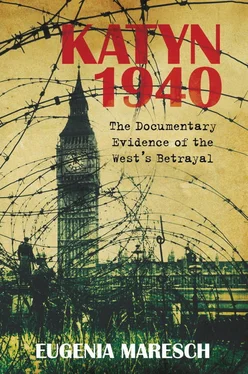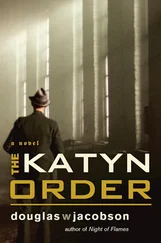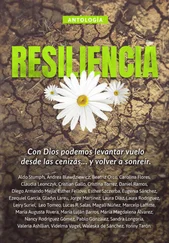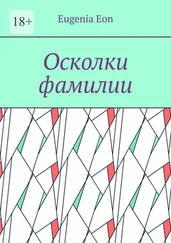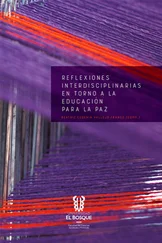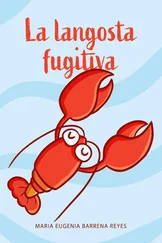We arrived at Smolensk about noon. In the afternoon, assisted by the Germans, we toured the city. In the evening in the officer’s mess we were introduced to three officers from the Propaganda Section of the Smolensk Army; two Lieutenants and one Captain. Lieutenant [Gregor] Slovenzik, of the reserve, [ Oberleutnant Gregor Slovenzik was attached to the propaganda service in Heeresgruppe Mitte in Smolensk], was born in Vienna, supposedly a journalist by profession, the second was a sculptor from Innsbruck. Listening to our conversation was a Lieutenant from the Geheimpolizei ; I expect it was Foss [ Leutnant Ludvig Voss, Geheime Feldpolizei sekretar, GFP Gruppe 570 ], of whom I learned later.
OLt Slovenzik gave us a more accurate version of Katyn, he showed us photographs of the woods, the corpses and the documents found on them. There were a few things worth examining…. The trail to the graves was found by Feldpolizei , who questioned the local people living near Koze Gory, which was part of the large Katyn woods, stretching along the Dnieper River and the main road running from Smolensk to Vitebsk. The local people maintained that for a long time Koze Gory was guarded by the NKVD as it was used as a place of execution, and that many thousands of Polish officers were shot and buried there in mass graves. Apparently, the Polish workers in the Organisation Todt [12] Organisation Todt derived its name from Herr Fritz Todt, an engineer and Minister of Armaments in 1940, an instigator of the German plan of building autobahn, motorways, by engaging unemployed workers in 1933. In wartime, this operation under the German Ministry of Labour used PoWs and civilians of the occupied countries as labour force, Arbeitsbeschaffung.
later found these graves. They inspected one excavated spot in the ground, and finding the statements of the locals to be true, erected a wooden cross, of which only a photograph exists, the cross must have disappeared when the first large excavations began. In any case, it served as a guide where to start the works. When asked if they had traced the Polish workers, they said no.
The second story, which is more interesting than the first, was that Slovenzik, who presented the events of Katyn in such dramatic terms from the Polish point of view – did not know where these massacred officers came from! He only knew from the locals that transports with officers arrived from Smolensk. He already had in his possession postcards and letters found on the corpses, so he was baffled why the address of Kozelsk appeared on them. I told him what I knew about the prison camps at Starobelsk, Ostashkov and Kozelsk, while keenly observing his reaction. His reaction was animated and made the impression on me that Slovenzik had learned something from us. This was also the only moment during our conversation that Slovenzik made notes. After our conversation had ended, I heard him sharing the news with Ohlenbusch and other Germans. I believe Voss was not in the mess at the time.
The following morning, we went to Koze Gory by car. We stopped in the woods and alighted near a long excavated ditch. The ditch was probably the length of the whole grave and to its bottom but not taking its whole width, as was shown by the arms, legs and heads left at the sides. The cross section indicated that the bodies were put in neat rows, one upon the other. The mass grave on the incline of the hill contained dry soil at the top and a mixture of clay and sand at the bottom, wet due to the water table. Nearby, we saw the excavation of another mass grave, showing only the first layer of bodies. The local Russian people did the work on both graves.
Next to the grave there was a temporary hut, where a team of pathologists under Dr Buhtz, [Gerhard Buhtz, Heeresgruppenartz Mitte , Head of Army Group Medical Services] Professor of Forensic Medicine from Wrocław [Breslau] was working. When in uniform, Prof Buhtz held the rank of a Colonel. It was evident that the excavation had only started. On a grass field nearby lay about 200 excavated bodies waiting for a post-mortem. The corpses were numbered and put in several rows. Around Buhtz’s hut several of them lay, probably already inspected. Parts of uniforms were hanging on the branches of the trees. The whole scene gave the impression of an as yet unplanned start to the work. Prof. Buhtz asked us to choose a body and he would perform a post mortem in our presence, so we pointed to one in the middle of the grave. The post-mortem showed a shot through skull with the entry and exit points of the bullet. The pockets cut open by knife during the post-mortem revealed a postcard addressed to a Cavalry Captain, whose name I do not remember, it was written by his wife and came from the Grodno region, sent to the Kozelsk address.
Among the bodies laid out around the hut were those of General [Mieczysław] Smorawiński and General Bohatyrewicz [Bronisław Bohaterewicz]. At my request, Dr Buhtz cut off Smorawiński’s rank insignia and the ribbon of the Virtuti Militari from the coat of Bohaterewicz. These items, together with some buttons from other overcoats and a handful of soil, I took with me to Warsaw. These reliquaries I kept at home until the Warsaw Uprising, when they were destroyed by fire along with my house.
We toured round the whole terrain and soon learned how to identify unearthed graves; their edges were sunken in, the surface uneven; besides, they had young pine trees planted on them, without a doubt purposefully. These small, even-size trees stood out among the rest of the woods, which was wild looking and neglected, although not that old. The pines planted on the graves looked healthy and well rooted, and must have grown for more than a year. Dr Buhtz gave me a list of names of the dead that he had already identified; there were about thirty names. I managed to update the list later in Grushchenka [a village] on my return journey.
During our stay in Koze Gory, broadcasts of German propaganda were transmitting the progress of our visit. They tried several times to entice us to state that the Bolsheviks committed the massacre. We tried to avoid it, but eventually, after being persistently harangued, I said only one sentence, that in my understanding, inside those graves there were bodies of prisoners of war from Kozelsk, about whom there had been no information since April 1940. Someone named Wąsowicz gave a longer and rather pathetic speech.
Before departing from Koze Gory I asked the Germans to leave us alone for prayers. They moved away and Director Seyfried said the following words: ‘I call the whole Polish delegation to hold a minute’s silence, to pay homage to those Poles who died so that Poland might live.’ I included these words when I wrote my report for the PCK and at my request, a copy was sent to the German Propaganda office.
Besides taking part in radio propaganda, we were not troubled by the Germans in any way. We had freedom of movement and the conversation we had with the local people were unrestricted and freely given. On our return journey to Smolensk, we stopped at Grushchenka, where at a roadside building, neatly arranged in glass show cases, were artefacts found on the bodies in Koze Gory.
I should mention that during our stay in Koze Gory, some delegates from our group talked with the local people, when I did not take part but listened. These people confirmed totally the German theory regarding Koze Gory as a place of longstanding scenes of crime, as well as of the shooting of Polish officers by the Bolsheviks. I did not take part in these talks, because lack of time and strained nerves did not allow us to ask more precise questions and receive answers.
That evening we returned to Warsaw. After that, I wrote a report for the PCK . Its copy, with my comments and the list of names of the first identified victims was sent via Buczkowski to ‘Hubert’, and through ‘Koral’ for Julian Piasecki. Presenting the report to the PCK I asked them also to send a copy to Dr Grundmann of ‘Propagandaamt .’ The reason why I acted this way had nothing to do with the ‘co-operation’ with ‘ Propagandaamt’ on Katyn. By sending a report for Grundmann, I wanted to force the German authorities to put the investigation into the hands of the Polish Red Cross – as well as to overcome the reluctance seen in the Red Cross and equally in other institutions, to look into the Katyn affair. Wanting to present the question more dramatically, I made several copies of the report and gave them to people I trusted. It is difficult now to tell who read and remembers the report. I know for certain that people who read it in Poland are: Jerzy Zagórski, Marian Buczkowski [Wilhelm] Horzyca, Józef Targowski and Alfred Wysocki. People living in England: Wiesław Wohnout and Lt Wiktor Trościanko.
Читать дальше
